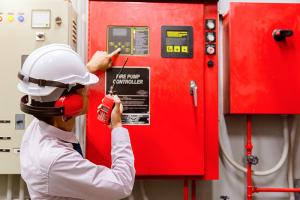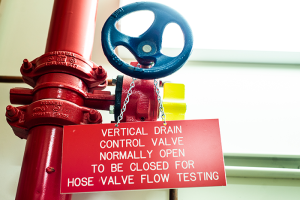Powering patient safety
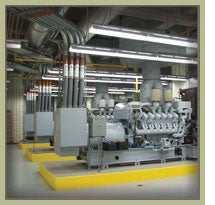 Health care facilities are required to have adequate emergency standby power systems to protect patients and critical systems during utility outages. Industry and regulatory guidelines set minimum standards for emergency standby power systems used in healthcare facilities.
Health care facilities are required to have adequate emergency standby power systems to protect patients and critical systems during utility outages. Industry and regulatory guidelines set minimum standards for emergency standby power systems used in healthcare facilities.
However, the way that individual hospitals configure and operate their standby power systems can be quite different. Depending on their size, location and willingness to embrace advanced technologies, hospitals can install a basic standby system, one with multiple redundancies or one that can actually generate savings on utilities bills.
Recent examples show the range of possible emergency standby power solutions. Each of the following hospital installations have provided individualized emergency standby power systems that not only meet or exceed health care facility standards, but bring added benefits that improve economics or operational flexibility.
Consolidation and peak shaving
Recognized as the region's leading health care provider, The Medical Center of Columbus (Ga.) Regional Healthcare System is a 400-bed hospital that offers a comprehensive menu of medical services. Rather than add to its mix of existing standby generators — some that were over 30 years old — The Medical Center decided to replace all of them with a central power plant equipped with four new 2,500-kilowatt (kW) generator sets. Not only does the new central plant provide emergency standby power for all of the hospital's current needs, but it also gives hospital personnel new flexibility in managing the power supply and utility costs, while ensuring enough backup power to accommodate future growth.
The new central plant, located across the street from the main hospital in a freestanding building, houses the new generator sets. With a total capacity of 10 megawatts (MW), the four units could provide the average power consumed by almost 1,000 homes with 200-amp service panels, according to Mark Smith, the hospital's director of facilities management.
Because of its mission-critical role, the hospital has provided for several layers of protection against power outages. For redundancy, the central energy plant is supplied by utility feeds from two separate substations. In the event that power from one utility feed is interrupted, power is automatically switched to the other utility feed. The standby generators get a signal to start if one of the utility feeds fails; however, if the second utility sources remain stable, the generators shut down and return to a standby state. A generator equipment failure won't cause problems for what Smith describes as a "totally redundant" system. "If any piece of equipment in this plant fails, there's a backup piece of equipment that will do its job," he says. "So you'd actually have to have multiple failures before the plant wouldn't operate."
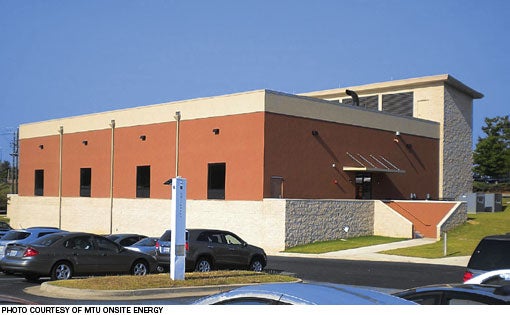 |
| A new central power building was constructed across the street from The Medical Center in Columbus, Ga., to house the four generator sets and paralleling switchgear. |
The generator sets produce power at 12,470 volts, which enables them to connect and distribute at the incoming utility voltage. This allows more economical power distribution to the rest of the campus, limiting losses from power transformation to that of the local load, thus increasing overall plant efficiency while lowering installation cost.
The central energy plant has many advantages over the former collection of standby generators. For one thing, the new plant has the capacity to power all electrical loads in the hospital, not just critical and life-safety branches, says Smith. Among other things, this gives the hospital greater flexibility in managing power use and cost. At any given time, the facility can be totally on the power grid, partially on the grid, or totally off the grid, depending on the situation.
Similarly, during the approach of a severe storm that might cause a power outage, the hospital can preemptively run its generators in parallel with the utility until the storm passes. The hospital has already done this once in the brief time the plant has been up and running. "We didn't lose power in that case, but it was still worthwhile," Smith says. "All you do is burn a few gallons of fuel, so there's little cost involved. But the payback could be tremendous. If we did it 10 times and lost power just once, it would be well worth it."
The Medical Center's new central power plant can also be put to use during extremely hot summer days, when power demand soars and utility rates jump. At such times, the hospital can run its backup generators to take some load off the grid and potentially save money on the cost of electricity. If the utility's price for electricity is higher than the cost of generating power onsite, Smith flips the switch on the new power plant. As a result, during some recent hot periods, the hospital was able to save approximately $5,000 per day in power costs, Smith reports.
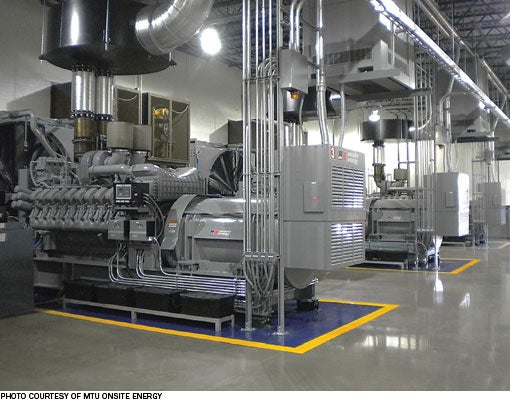 |
| Four 2,500-kW generator sets provide standby power and load management functions for The Medical Center. |
Capacity and natural disasters
Halifax Health is the largest medical center in east-central Florida, with 944 beds and 500 physicians representing 46 specialties. Founded as a small community hospital in 1928, it has steadily expanded over the decades, and is now consistently ranked in the top five percent of all medical centers in the country in clinical outcomes. When Halifax Health recently added the new, 10-story France Tower to the campus for inpatient and emergency treatment, it selected a 6-MW emergency standby power system.
The France Tower contains one of the largest operating rooms on the East Coast in addition to a central energy plant that houses the new standby generators, boilers and chillers. Having a reliable standby power system is not only required by code but necessary as a practical matter, as this area of coastal Florida is hit frequently by hurricanes and thunderstorms that cause disruptions in grid power.
"Summertime thunderstorms regularly wreak havoc with our local utility due to lightning strikes, but these outages tend to be of short duration," says James Sawyer, electrical supervisor, Halifax Health. "However, there's always the threat of bigger storms." As testimony to the constantly looming danger, the new France Tower has been constructed to withstand a Category 5 storm, Sawyer says. "I've been at Halifax for 30 years, and haven't found anything that Mother Nature can do that I can't get around, re-feed and get the power going. I have a very high comfort level with the new units. No matter the type of power outage, we are there for the patient."
The power system for the France Tower consists of four 1,500-kW generator sets operating in parallel for a total capacity of 6 MW. The electrical loads are prioritized and segmented by up to eight closed-transition automatic transfer switches per generator set. When an outage occurs, all four generator sets start and assume the load when they are up to speed. If the control system detects that only two generator sets are needed to supply the loads, one generator will shut down for bus optimization and fuel saving.
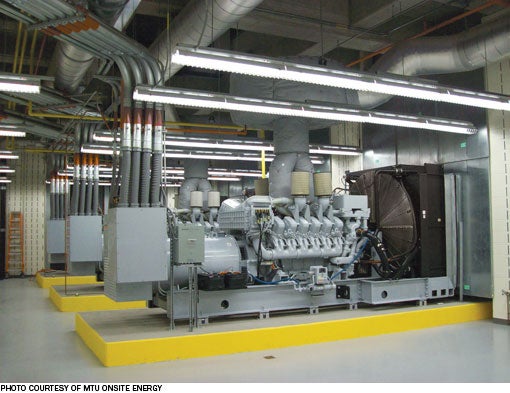 |
| A 6-MW emergency backup system supplies all the power for the France Tower at Halifax Health. |
Sophisticated and sensitive backup
St. Joseph's Healthcare Hamilton (SJHH) in Ontario, Canada, a teaching hospital affiliated with McMaster University, is known as a regional "center of excellence" for a variety of surgical specialties as well as minimally invasive surgery and surgical robotics research. With a 120-year history of caring for the communities surrounding Hamilton, SJHH recently expanded its specialties with a new three-story surgical/perioperative tower. The tower's 100,000-plus square feet of new construction and renovation features new surgical rooms, post-anesthesia care beds, a day surgery center and sterile-processing department.
The sensitive electronic equipment in SJHH's new unit requires sophisticated electrical backup power. The emergency power systems are designed to accept changes in loads with minimal voltage and frequency dips. This transient response, or ability to respond quickly to variations in loads, ensures that surgical procedures and patient safety will not be compromised in the event of a power failure.
The power system consists of two 550-kW generator sets that meet the electrical requirements of the Canadian Standard Association's CSA 282/32. This standard mandates that the units provide power at a steady state within three seconds after 75 percent of the load is applied.
Each generator set is powered by a 12-cylinder engine designed specifically for power generation.
Varying institutions and needs
As health care institutions continue to grow, their emergency standby power needs will also grow and change. Based on evolving hospital design criteria and continuous attention to quality patient care, there will be a need for varying levels of sophistication in backup power systems. While every hospital has a similar mission to protect the safety and well being of its patients, each also has unique missions and core objectives that affect the design of its emergency standby power system.
Kevin McKinney is a regional sales manager for MTU Onsite Energy, Mankato, Minn. He can be reached at kevin.mckinney@mtu-online.com.


